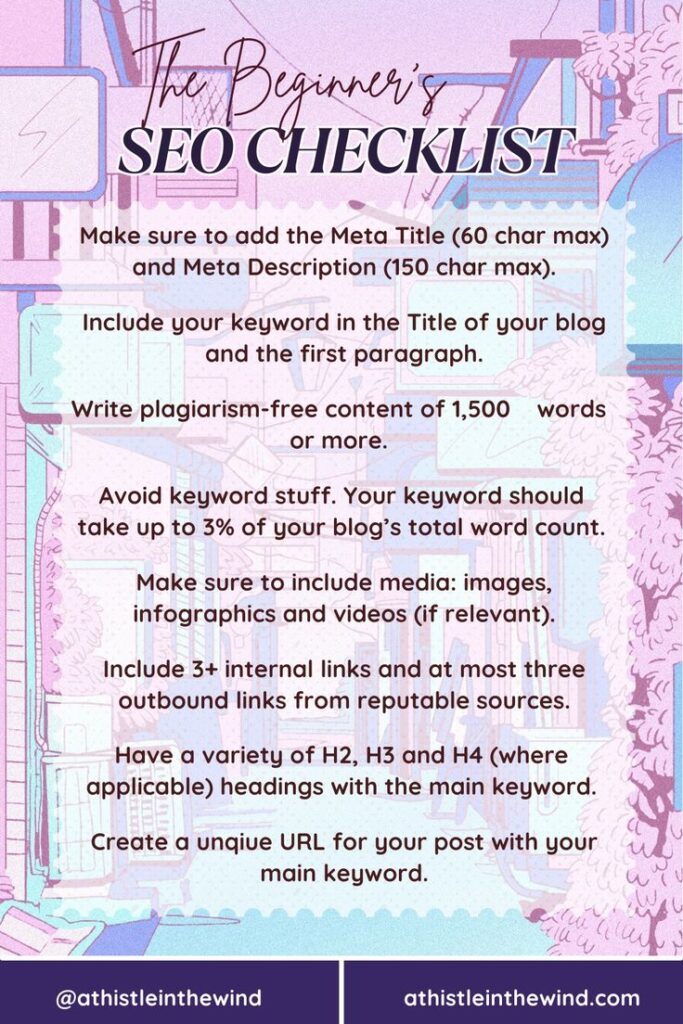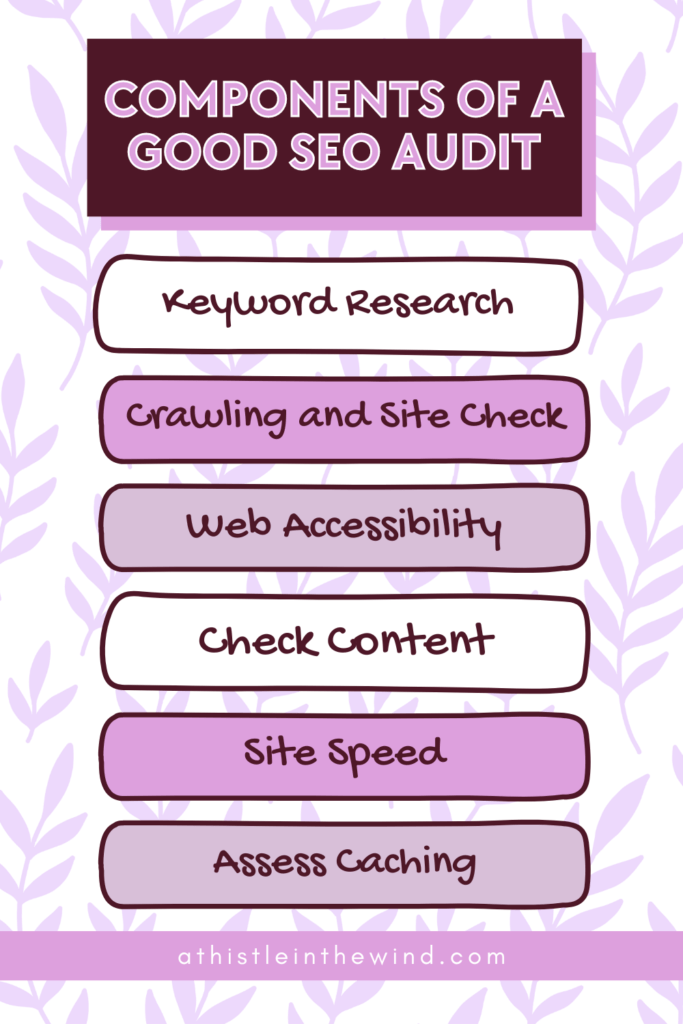SEO 101: What is an SEO Site Audit? A Guide for Newbies

I feel like we’re on a roll when it comes to SEO articles here. What can I say? SEO’s important, especially now. I’ve already written a blog on developing an SEO strategy, a sort of beginner’s guide to SEO and I’ve also created a list of free SEO tools, and courses you can take.
One of the first things you’re going to do as a blogger is audit your site. Performing an SEO site audit is really important. It ensures that your website’s optimised for search engines. As I’ve mentioned multiple times, audits are a critical part of any SEO strategy. They help to identify where your site may have problems and help you to prioritise your SEO actions. They can also help to enhance the credibility and trustworthiness of your website, ultimately attracting more visitors and potential customers.
Back in the day, SEO site audits used to take weeks, if not months if you had a lot of content on your site. Pro-tip: if you have less content on your site like mine does, keep going back and optimising your content once every three months.
For larger blogs, I’d suggest optimising ALL your content every six months, starting with the ten most popular blog posts on your site.
Now, we have a lot to cover today, so let’s get right into it.
What is an SEO Audit?
An SEO site audit is a fundamental and ongoing process crucial for maintaining a website’s competitiveness in the digital landscape.
This comprehensive evaluation, ranging from technical aspects to content quality and user experience, allows businesses to identify and rectify issues that may impact search engine rankings and user satisfaction.
A well-executed site audit not only addresses immediate concerns but also sets the foundation for continuous improvement, helping websites stay aligned with evolving SEO best practices. By systematically analysing elements such as crawling, accessibility, keywords, content quality, and technical SEO, businesses can create a strategic roadmap for optimization.
Regular SEO site audits empower websites to adapt to algorithmic changes, enhance user experience, and ultimately, solidify their online presence in a dynamic and competitive environment.
Components an SEO Site Audit
1. Keyword Research
Keyword research is an essential part of any SEO audit. It helps you identify the words and phrases that your target audience is searching for, and how to optimise your content accordingly. Before you start looking for keywords, you need to have a clear idea of what you want to achieve with your SEO audit.
Start by examining your current keyword strategy, reviewing the keywords associated with each page. The most important thing to look for when doing keyword research is the monthly traffic volume and competitiveness for a target keyword. Not all keywords are worth optimising for, so you should be looking for the important keywords that are easy to rank for your site.
Utilise tools like Google Keyword Planner, Semrush, or Ahrefs to identify new and relevant keywords, assess search volume, and understand the level of competition. These tools can help you find relevant keywords, analyse their search volume, difficulty, and competition, and discover related terms and variations. You can also use them to spy on your competitors and see what keywords they are ranking for.
Types of Keywords
1. Short tail keywords
Short tail keywords are between one to two words in length. These keywords have the highest search volume but also the largest competition. Short tail keywords are hard to rank for and it can take a lot of money and time to get to page one on Google for them.
Therefore, it’s better to skip these types of keywords when doing your keyword research unless you’re doing search engine optimization for a large and well-established brand. Short-tail keywords are often associated with informational queries. They’re commonly used in the early stages of the user’s search process when they are exploring a general topic.
Due to their simplicity, they tend to have high search volumes, attracting a large audience. While short-tail keywords offer the advantage of potentially high traffic, they also come with challenges.
The competition for these keywords is intense, as many websites are vying for visibility. Additionally, short-tail keywords may not provide a clear indication of the user’s intent, making it challenging to tailor content to their specific needs.
2. Middle tail keywords
Middle-tail keywords are between three to four words in length. These keywords have moderate search volume and average competition. Middle-tail keywords are good to choose when doing keyword research because there are many untapped terms in the market. You can often find three to four-word terms that are easy to rank on the first page of Google for any business.
These keywords typically consist of three to four words and offer a balance between generality and specificity. Mid-tail keywords are more targeted than short-tail keywords, allowing for a more refined focus on a particular topic or niche while still maintaining a moderate search volume.
Mid-tail keywords strike a balance between generality and specificity, making them suitable for businesses or content creators aiming to target a more defined audience. These keywords provide a clearer understanding of user intent compared to short-tail keywords, allowing for more targeted content creation.
Mid-tail keywords help attract users who are further along in the buying cycle and are seeking more specific information. They contribute to a well-rounded keyword strategy by capturing a more engaged audience while avoiding some of the challenges associated with extremely competitive short-tail keywords or highly specific long-tail keywords.
3. Long tail keywords
Long tail keywords contain five words or longer. These keywords have the lowest search volume but also the least competition.
Picking long-tail keywords is a good way to improve your SEO fast to generate more traffic. Bigger brands often skip long-tail keywords when doing keyword research because they don’t deem them to be important.
Long-tail keyword is more specific. It addresses a user who is specifically interested in comparing the camera features of the latest smartphones.They’re often associated with users who are deeper in the buying cycle, conducting detailed research before deciding. Long-tail keywords attract users with a very specific intent, making them more likely to convert or engage with your content.
Due to their specificity, long-tail keywords often face less competition compared to shorter, more general keywords. Content optimised for long-tail keywords is more likely to directly address the user’s query, providing a more relevant and satisfying experience. While incorporating long-tail keywords into your SEO strategy may not generate as much traffic as targeting broader terms, they are instrumental in attracting a highly relevant audience and can contribute to a more effective content marketing strategy.
Make Sure You Do It Right!
It’s essential to strike a balance between short-tail, mid-tail, and long-tail keywords to create a well-rounded and comprehensive keyword strategy. Keyword research allows SEOs to understand the competitive landscape by giving them a clear picture of who they’re competing against. For instance, let’s say you’ve got an idea for a piece of content that you’d like to produce. By doing proper keyword research, you’ll be able to see which domains are already competing for the respective keyword(s).
Keyword research gives insights into how difficult or easy it will be to rank in the top spot in Google search and other search engines. Beyond just targeting high-volume keywords, consider user intent and how well your content addresses the needs of your audience. This thorough keyword analysis will not only optimise your site for search engines but also enhance the user experience by aligning your content with the language and queries your target audience is likely to use. Regular updates to your keyword strategy based on ongoing trends and shifts in user behaviour will keep your website’s SEO efforts agile and effective.
2. Crawling and Site Check

A crawler is an internet program that browses the internet systematically. They’re usually used by search engines to discover and process pages for indexing and showing them in the search results.
The crawler navigates through links, analysing elements such as metadata, header tags, and URL structures. This reveals critical information about your website, including broken links, duplicate content, missing meta tags, and other issues that may hinder search engine visibility.
Website crawling isn’t just a one-time event – it’s an ongoing practice for active websites. Bots will regularly recrawl websites to find and add new pages to the search index while also updating their information about existing pages.
To ensure that your website is ready for crawling, there are a few steps:
Check your robots.txt file
The robots.txt file is the file on your website that communicates with the bots, using a series of crawler directives. The robots.txt file is located in the root directory of your website, which you can usually view by navigating to yourwebsite.com/robots.txt. To edit your robots.txt file, you’ll need an FTP client or access to your host’s cPanel.
Once inside the robots.txt file, you’ll want to ensure that it’s not disallowing good bots from any pages or sections. Check for further instructions, such as a “nofollow” meta tag in the section of your HTML page or a “nofollow” link attribute in the page’s HTML code.
If you understand the directives within a robots.txt, just viewing it will be enough to check for these errors, such as an incorrect noindex or nofollow directive. Otherwise, you can use a robots.txt testing tool. For Googlebot specifically, you can use their robots.txt tester.
Submit sitemaps
The next step is to submit your sitemap. This is a simple text file in XML format that lists all the indexed pages. If you want to submit the sitemap URL manually, this is what it looks like in Google Search Console under Index > Sitemaps.
The process will be similar for other popular search engines, such as within Bing Webmaster Tools.
Fortunately, creating sitemaps doesn’t have to be a complicated step. If your site runs on WordPress, any popular SEO plugin – such as Yoast or Rank Math – will automatically generate the sitemaps for you and provide the sitemap URLs for you to submit.
Once you have completed your crawl, you will receive a report that summarises the findings and issues of your website. The report may vary in format and detail, depending on the tool you use, but it generally includes information such as the number of pages crawled and their status codes, page titles, descriptions, and headings, internal and external links, images, videos, and other media, canonical tags and redirects, page speed and load time, meta robots and indexability, and structured data and schema markup. You can use crawler tool, such as Screaming Frog or Ahrefs, to scan your website and identify any issues or errors that might affect its structure and crawlability.
Fix Broken Links, Duplicate Content and More!
A crawler tool can help you find broken links, redirect chains, duplicate content, orphan pages, missing or incorrect meta tags, and other problems that can hurt your SEO and user experience. Ahrefs can identify 100+ pre-defined SEO issues, including performance, incoming links, content quality, and more.
It also allows you to segment out the data with custom filters and URL parameters. The crawl can occur on a daily, weekly, or monthly basis, and mobile crawls are also possible.
By identifying and addressing these crawl-related issues, you enhance the overall accessibility and indexability of your site, ensuring that search engines can efficiently navigate and understand your content. This foundational step sets the stage for more in-depth analyses, allowing you to optimise the structure of your website and pave the way for improved search engine rankings and user experience. Regular site crawling is essential for staying proactive in addressing potential issues and maintaining a healthy online presence.
3. Web Accessibility
Having an inclusive and easy-to-follow web product is essential. Your visitors want an easy experience, and you’re expected to deliver. That includes making your website inclusive for everyone.
A web accessibility audit can help you meet these standards. To have an accessible digital product is in high demand and can set you apart from the competition. Accessibility will only become more important with the growth of digital space.
Checking website accessibility is not a one-time task, but an ongoing process that requires regular testing and evaluation. By checking website accessibility, you can identify and fix any issues that may prevent some users from accessing your content, functionality, or design.
You can also ensure that your website meets the Web Content Accessibility Guidelines (WCAG), which are the internationally recognized standards for web accessibility. Moreover, you can benefit from better SEO, as many accessibilities features also align with SEO best practices, such as using descriptive headings, alt text, and semantic markup.
Another way to check website accessibility is to use automated tools that can scan your website and generate reports on accessibility issues. These tools can save time and effort, but they aren’t able to detect all the possible problems or evaluate the context and quality of your website.
Therefore, manual testing and human judgement should always be used in addition to automated tools. Popular automated tools for checking website accessibility include WAVE, Lighthouse, and WebAIM Contrast Checker.
Tools That Can Help
- WAVE provides visual feedback and suggestions on your website and can be used as a browser extension or web service.
- Lighthouse is a web performance and quality auditing tool that includes a web accessibility category and can be used as a browser extension, web service, or command-line interface.
- WebAIM Contrast Checker allows you to check the colour contrast of your website against the WCAG standards by entering the foreground and background colours or using the colour picker.
Gaining valuable insight into how your website meets the needs and expectations of your target audience requires involving real users with disabilities or assistive technologies in the testing process. You can do this by recruiting users to test your website in person or remotely via platforms like UserTesting.
Prioritising accessibility not only enhances your SEO efforts but also fosters a more inclusive and positive user experience, contributing to the overall success and reputation of your online presence. Regular assessments and improvements based on accessibility guidelines will support your commitment to providing an equitable and accessible website.
4. Check Content

Quality content is how relevant, engaging, and useful your content is for your audience. Content quality goes beyond words on the page. Every single content marketer out there has their own way of creating high quality content. Before you dive into writing a slew of content it is very important for you to identify your audience and what they want.
You can’t just write anything and expect audiences to come to your website—you have to create content that is written for your audience. You want your content to resonate with your audience so that they will come back and/or share.
Search engines, such as Google, prioritise delivering the most relevant and valuable results to users, and content quality is a key metric in determining relevance. High-quality content demonstrates expertise, authority, and trustworthiness (E-A-T), principles highlighted in Google’s search quality guidelines.
During an SEO audit, assessing content quality involves scrutinising factors like accuracy, depth of information, uniqueness, and overall readability. Well-researched, informative, and original content not only attracts users but also encourages longer on-site dwell times and reduces bounce rates, signalling to search engines that the content is satisfying user intent.
Tools to Use
Tools like Screaming Frog, Google Analytics or Semrush are a great solution to help efficiently crawl your site pulling out all existing content, even content you may not have realised you had. If the idea of tackling this stage daunts you, why not get in touch, we can help. Your SEO should inform your content, but the focus should always be on creating content for the people who will consume it.
If you’re putting fresh, unique and relevant content out there – that is to say, high-quality content – people are more likely to consume it, engage with it and share it. The right kind of people too. This, in turn, will increase your brand’s exposure, build up consumers’ trust in your business, and ultimately improve your search engine rankings.
The nature of the internet lends itself to website readers hunting for solutions and actionable content that they can use. So, your content needs to provide readers and website visitors with something solid and concrete, something they can rely on.
Moreover, quality content is more likely to earn backlinks from authoritative sources, further boosting a website’s credibility and search engine visibility. Addressing content quality in an SEO site audit involves identifying and rectifying issues such as duplicate content, keyword stuffing, or thin pages.
Regularly updating and expanding content, along with aligning it closely with user search intent, ensures sustained visibility in search results and a positive user experience. In essence, content quality is the cornerstone of effective SEO, influencing how a website is perceived by both users and search engines.
5. Site Speed
There are so many factors that go into designing and launching a successful site, but page speed can be easily overlooked. Novice business owners may not realise how important page speed is for SEO, especially since the ranking factors change quite often. Having a good page speed impacts organic ranking, improves user experience, and can directly impact conversion rates. The most recent update to Google’s Core Web Vitals Algorithm was intended to optimise the search experience by measuring page load time, as well as interactivity and visual stability as pages load.
Google has indicated that site speed (and as a result, page speed) is one of the signals used by its algorithm to rank pages. And research has shown that Google might be specifically measuring time to first byte as when it considers page speed. In addition, a slow page speed means that search engines can crawl fewer pages using their allocated crawl budget, and this could negatively affect your indexation.
A fast-loading website provides a better user experience. When users can quickly access the content they’re looking for, they’re more likely to stay on your site, engage with your content, and convert (make a purchase, sign up, etc.). Slow-loading websites frustrate users and increase the likelihood of them leaving your site, which can result in higher bounce rates and lower engagement metrics. Google has explicitly stated that page speed is a ranking factor, and search engines, in general, prioritise delivering fast and efficient results to users.
What to Do During the Audit

During an SEO site audit, assessing site speed involves analysing the loading times of individual pages, identifying bottlenecks, and addressing issues that might hinder optimal performance. Slow-loading pages can lead to higher bounce rates, lower user engagement, and ultimately, a negative impact on search engine rankings.
Over the years, pages have only increased in size, and the popularity of JavaScript made them even more complex and harder to load. Loading a web page can still be a drag, even with lightning-fast internet connections and potent devices. “page speed” is not necessarily about how fast a web page can load but more about how quickly it can provide a good user experience.
Even if the page’s main content is quick to load, but other elements take longer to appear, you’ll still feel like the page is slow because you have to wait before you can interact with it. When you click on a link to visit a web page, your browser has to make a request to the server of the website asking for content and other information. That content has to be loaded fully or partially on the browser before the user can interact with the page. At the same time, many things happen when a page gets loaded. You see things start appearing and popping up on your screen. After a brief moment, you can begin to interact with the page.
Don’t Forget About Mobile
Additionally, as mobile devices become increasingly prevalent, site speed gains even more prominence, as slower loading times can severely affect the mobile user experience. To evaluate site speed, various tools such as Google PageSpeed Insights or GTmetrix can be employed, providing insights into areas for improvement, such as image optimization, browser caching, and script minification.
Addressing these issues not only enhances SEO but also contributes to a positive user experience, which is a crucial factor for retaining visitors and converting them into customers. Your server response time is affected by the amount of traffic you receive, the resources each page uses, the software your server uses, and the hosting solution you use.
To improve your server response time, look for performance bottlenecks like slow database queries, slow routing, or a lack of adequate memory and fix them. The optimal server response time is under 200ms. Be sure that your images are no larger than they need to be, that they are in the right file format and that they are compressed for the web.
6. Assess Caching
In an SEO site audit, caching is assessed to ensure its configured optimally. There are different types of caching, including browser caching and server-side caching. Browser caching allows frequently used resources to be stored on a visitor’s device, reducing the need to download them repeatedly. Server-side caching involves storing static files on the server itself, minimising the processing load when a user requests a page.
Caching involves storing static versions of a website’s files, such as HTML, CSS, and images, on the user’s device or on intermediate servers. When a visitor returns to a cached page, the browser can retrieve these static files locally, reducing the need to fetch them from the server again. This significantly accelerates page loading times and enhances overall website performance.
Use CSS sprites to create a template for images that you use frequently on your site like buttons and icons. CSS sprites combine your images into one large image that loads all at once (which means fewer HTTP requests) and then display only the sections that you want to show.
This means that you are saving load time by not making users wait for multiple images to load. Regularly reviewing and optimising caching settings contributes to sustained improvements in site speed, positively impacting both user experience and search engine rankings.
Google’s Checklist
Since so many things can affect site speed, Google breaks everything up in different categories in the PageSpeed Insights Tool, for a better understanding of the issues.
This is helpful as Google also provides some sort of prioritisation, showing you what exactly affects speed the most. Addressing these issues not only enhances SEO but also contributes to a positive user experience, which is a crucial factor for retaining visitors and converting them into customers. Therefore, in the context of an SEO site audit, prioritising and optimising site speed is imperative for maintaining a competitive online presence and meeting the evolving expectations of both users and search engines.

The Role of Social Media
A social media audit tracks, measures, and analyses your existing social profiles and the performance of the content you publish. Social media audits are important because most companies have multiple accounts across different social media channels. A social media audit is like a report card for your social strategy.
It measures how well your social content is performing on different accounts and networks. An audit identifies what you’re good at, what needs improvement, and suggests the next steps to make things better. Networks like Facebook and Twitter are always changing their algorithms. And user behaviour is changing even faster than that. So, what worked yesterday may not work tomorrow. That said, lots of businesses don’t even know what’s working right now. They may spend big money on staff to keep their profiles active. But they don’t have a way to see if their efforts are paying off.
Exploring Social Media As Part of Your SEO Site Audit
During an SEO site audit, social media presence is evaluated by assessing the integration of social sharing buttons, the consistency of branding across platforms, and the level of engagement on social channels. Social signals, such as likes, shares, and comments, can indirectly influence search engine rankings by indicating content relevance and popularity.
Therefore, it is essential to ensure that your website’s content is easily shareable on social media platforms. Social media profiles contribute to building a brand’s authority and credibility, which can positively impact search engine rankings. A strong social media presence also helps in reaching a wider audience and driving traffic back to the website, potentially increasing the chances of acquiring natural backlinks.
In an SEO site audit, it is important to verify that social media profiles are linked correctly, and that the website is effectively leveraging social media for content distribution and audience engagement. Social media audits are incredibly valuable. It’s almost impossible to run a cohesive social media marketing campaign without starting with an audit. Team up with accounts in shoulder industries.
When it comes to opportunities, people in shoulder industries are the sweet spot. Their audiences overlap with yours. But they aren’t direct competitors. Offer to team up by doing a collaboration, account takeover, shout-for-shout or something else. By incorporating social media considerations into an SEO site audit, businesses can enhance their online visibility, build brand authority, and indirectly contribute to improved search engine rankings through increased engagement and content dissemination across various social platforms.
Tools to Help with an SEO Site Audit
There are many tools available to assist with different aspects of an SEO audit, such as crawling, indexing, keyword research, content analysis, link building, and user behaviour.
1. Screaming Frog SEO
Screaming Frog SEO Spider is a valuable tool for SEO audits due to its ability to comprehensively crawl websites, analyse on-page elements, evaluate URL structures, assess website performance, generate insightful reports, and facilitate internal linking analysis. It also helps identify missing or duplicated meta tags, ensuring that each page is appropriately optimised for search engines.
2. Semrush
Semrush also offers a range of functionalities, making it highly beneficial for conducting thorough SEO audits. One of Semush’s key features is its ability to perform in-depth website audits. The Site Audit tool identifies and prioritises technical SEO issues, such as crawl errors, broken links, duplicate content, and issues with meta tags. This allows SEO professionals to address these issues systematically, leading to improved website health and better search engine rankings.
Semrush’s On-Page SEO Checker is particularly useful for analysing individual pages. It provides actionable recommendations for optimising on-page elements such as meta tags, headers, and content. The tool also suggests semantically related keywords, helping users align their content with user intent and search engine algorithms. Keyword research is a strong suit of Semrush, and its Keyword Magic Tool is invaluable for SEO audits. It allows users to discover relevant keywords, assess their search volume and competition, and identify potential gaps or opportunities. Backlink analysis is another area where Semrush shines.
Its Backlink Audit tool helps identify toxic backlinks that may harm a website’s SEO performance. Users can disavow harmful links and focus on building high-quality, authoritative backlinks to improve the site’s link profile. Furthermore, Semrush facilitates the creation of insightful reports through customizable dashboards and PDF reports. This makes it easy to communicate audit findings to stakeholders and track progress over time.
Using AI for Better SEO Site Audit

AI technologies can be applied to various aspects of SEO audits to improve efficiency and effectiveness. SEO audits can be time-consuming, complex, and prone to human errors. That’s why you might want to consider using AI to improve your SEO site audit and get more accurate, actionable, and efficient results. AI can help you analyse your keywords and identify the ones that are most relevant, competitive, and profitable for your niche.
You can use AI tools to generate keyword suggestions, analyse search intent, and optimise your content for semantic relevance. AI can also help you avoid keyword cannibalization, which occurs when you target the same keyword on multiple pages and dilute your ranking potential. Creating high-quality content can sometimes feel like solving a puzzle, but AI content writing tools can help turn this complex task into a simple one.
Remember the Downsides Though
AI lacks the intuition that is essential for SEO success; it cannot understand the context, tone, and emotion of your content, or the intent, preference, and behaviour of your visitors. Furthermore, AI is dependent on data and algorithms, which can be influenced by biassed, outdated, or incomplete data, or by faulty, complex, or opaque algorithms.
Ethical and legal issues can also arise when using AI for SEO audit; it can pose risks to the privacy, security, and ownership of the data and information that are collected and processed by it, or to the accountability, transparency, and fairness of the decisions and actions that are made and taken by it.
Of course, AI-powered technologies will continue to shape the field of SEO, creating a much better user experience. But staying up-to-date with AI advancements and leveraging its potential will be necessary for success in the ever-evolving digital landscape.
No doubt, the future of SEO is interlinked with AI. Embracing AI technology and leveraging its capabilities will be crucial for businesses to stay ahead of the competition in the evolving digital landscape. By implementing the power of automation, you can optimise SEO strategies, drive organic traffic, and achieve sustainable growth. SEO with AI is full of possibilities and opportunities.



One Comment
Shirley Padgett
Ahaa, its pleasant discussion about this paragraph here
at this weblog, I have read all that, so at this time me also commenting at this place.